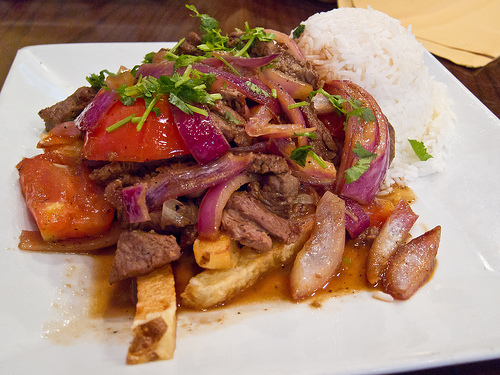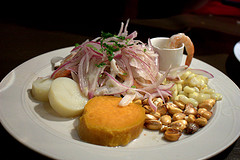My first real exposure to Latin American culture occurred one day in Washington, DC w
hen Nora, a Peruvian friend, walked me two blocks from our office to a small Peruvian restaurant, El Chalán. In the basement of a huge townhouse, only those in the know would ever even have noticed the place. The waiters were all Peruvian, only Spanish was spoken, and most of the patrons were Peruvian. This is where I discovered how versatile Peruvian cuisine is, coming from a mishmash of Native and Spanish influences with a little bit of Chinese fused in. It is one of the world’s finest.
The Illustrated Guide to Peruvian Food: 9 Dishes You Need to Try
1. Ceviche
Ceviche is raw fish caught fresh from the Pacific and “cooked” in citric acid. The fish is then created with onions and jai peppers and services at lunch with choclo (corn) from the Andes. Some people request the citrus juice that the fish was marinated in, and they drink it. This is what is known as leche de tigre, tiger’s milk, and if you drink it, you too will probably roar. People usually drink beer, like Pilsen Callao or Chicha Morada.
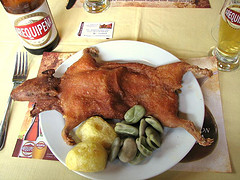 2. Cuy
2. Cuy
Next, make sure you try the cuy. Ever heard of it? It’s Guinea Pig, those fat little pets that roam the country of Perú, like rats. They are raised domestically, and meat is a national pastime. In fact, it’s so revered that there is a portrait of Da Vinci’s Last Supper in a chapel that depicts Jesus and the Disciples around a plate of cuy. The meat is bony as you can imagine; it is after all a little beast. The whole animal, including the head (as seen in this photo) is served up from the spit directly to the table. Many who have tried it say that it tastes like a wild rabbit or another game.
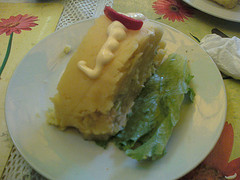 3. Causa
3. Causa
If you want to head over to the local market for a bite to eat, make sure to check out the potatoes and avocados. There are so many of her that you could literally be crushed by them. These two ingredients: avocados and potatoes are part of the causa casserole, which is layered with sliced veggies and served cold. In addition, they may even include tuna, or hard-boiled eggs in the mix.
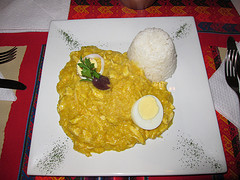 4. Ají de Gallina
4. Ají de Gallina
Ají de Gallina is a dish served with a yellow pepper which is used in a rich sauce with rice.
5. Lomo Saltado
Did you know that Perú was the landing spot for Chinese immigrants at one point? Many came to the country looking for a new life and work. When they came to the shores of Perú they brought with them their cuisine. They embedded their footprint here which of course caused a fusion of Asian and Peruvian foods. Lomo Saltado is a stir fry that has beef (or chicken), tomatoes and onions in a soy sauce. It’s also cooked up with french fries. They serve it over rice and it’s another national dish to try. See the main photo of this article to see how it looks.
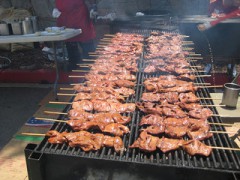 6. Anticuchos
6. Anticuchos
Anticuchos can be found on street-carts and street food stalls (anticucheras). It can be made with different types of meat cut in chunks and inserted in a wooden skewer. The meat is marinated in vinegar and spices (such as cumin, aji pepper and garlic). The most popular type is the one made with beef heart (anticuchos de corazón). Anticuchos often come with a boiled potato. It is one of the cheapest plates in Perú, but also one of the tastiest ones.
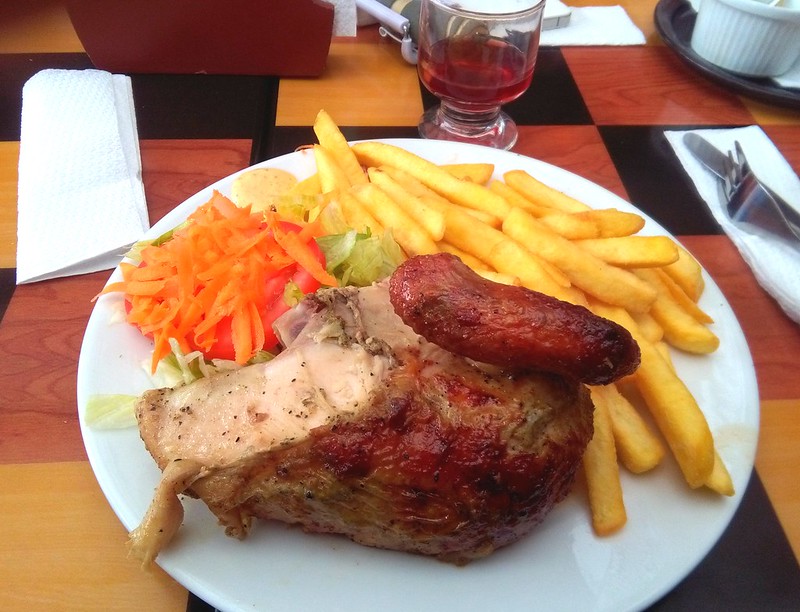 7. Pollo a la Brasa con Papas Fritas
7. Pollo a la Brasa con Papas Fritas
People usually go to the Pollerías and eat Pollo a la brasa con papas fritas, or grilled chicken with french fries. They are usually big, so if you go in groups, you can eat one among four people, or half if you are hungry.
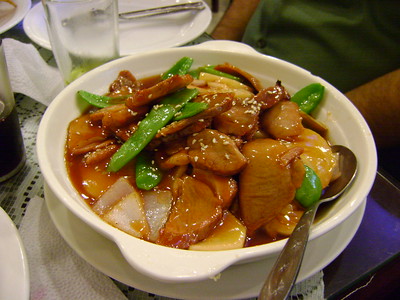 8. Chifa
8. Chifa
Chifa or Chinese food is excellent in Perú. It has like a Pekin style but adapted to the Peruvian taste. It is very tasty. You can have Taypa, which is a mixture of different meats in a dark sauce, Kamlu Wantan, which is fried wonton, with pork, vegetables and is sweet and many others that are really important to try. People in Perú usually drink Inca Kola, with this kind of food.
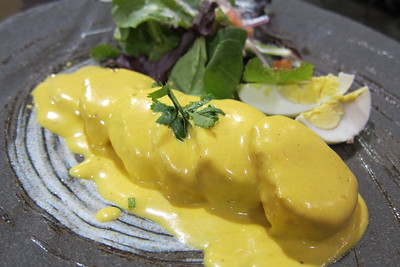 9. Papa a la Huancaína
9. Papa a la Huancaína
Papa a la Huancaína is a dish made with boiled potato in a creamy spicy sauce. It is from the area of Huancayo.
And to wash down all that food, a pisco sour is a must. If you are offered the pisco sour catedral, hold on to your hat, that’s a double size pisco sour.
Traveling to Peru?
For more drinks ideas check out a previous Speaking Latino article The Peruvian Bar: 7 Drinks from Perú You Should Try and my ebook Quick Guide to Peruvian Spanish.
Trying local food is an excellent way of learning new vocabulary. So, what’s your favorite Latin American cuisine and why?
Check out these other Peru Culture articles.
Featured photo credit: KayOne73 via photo pin cc
